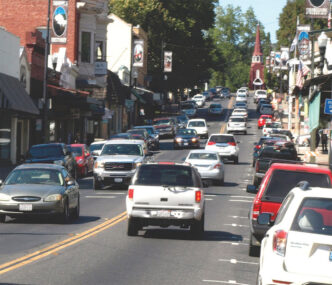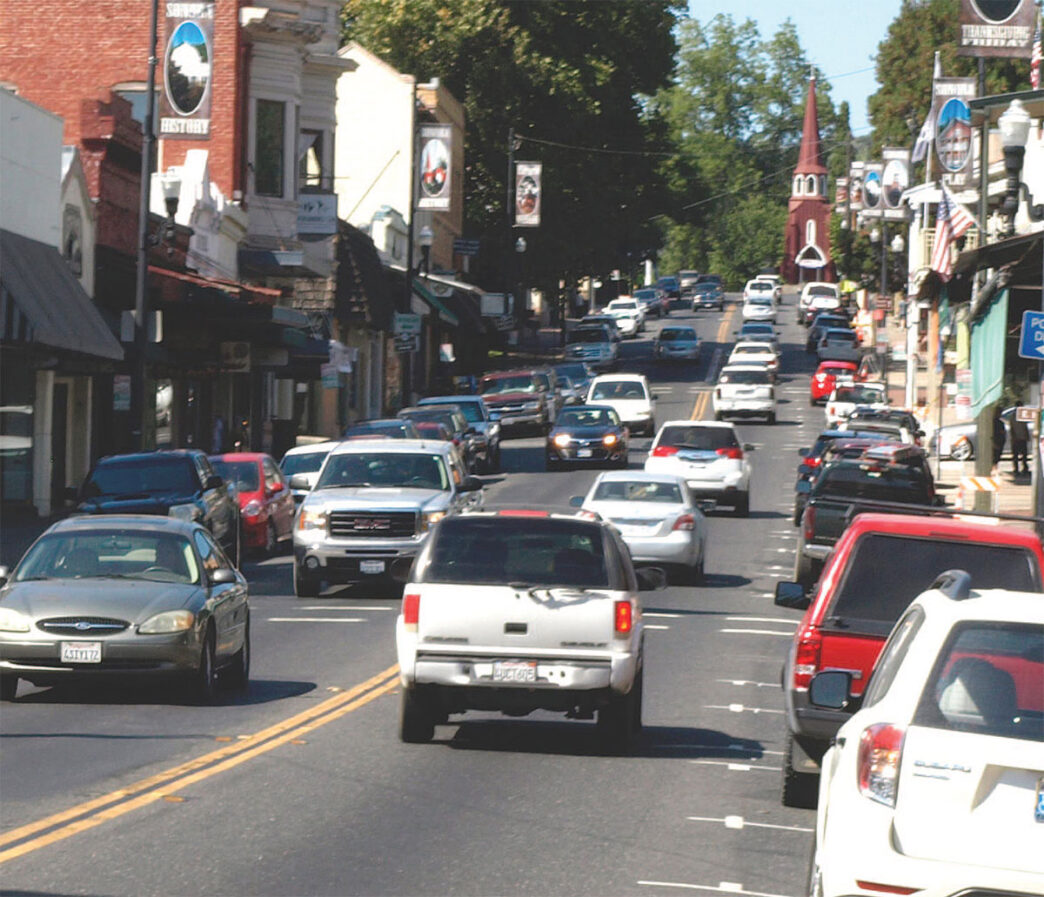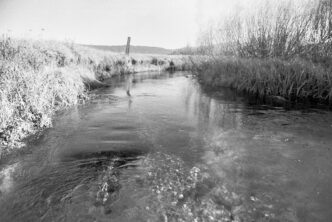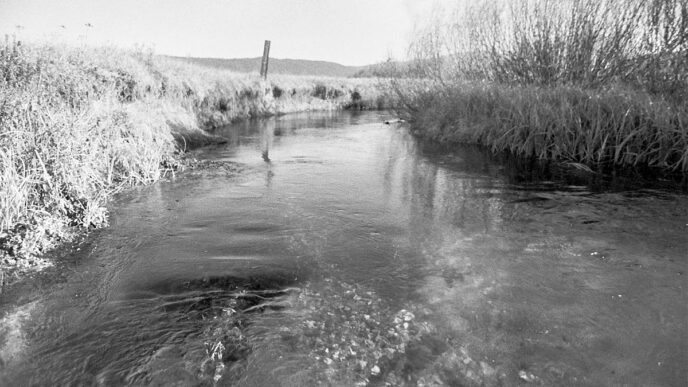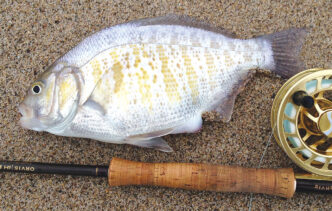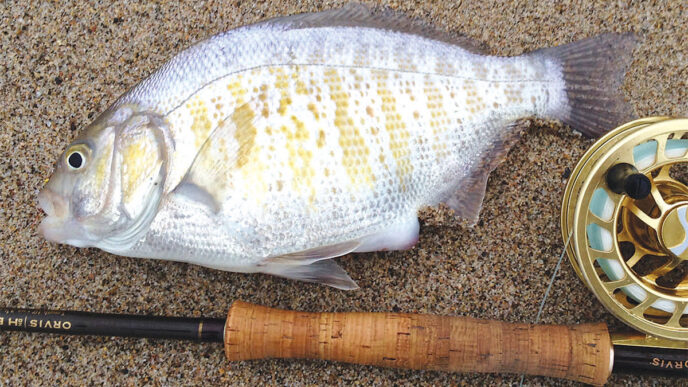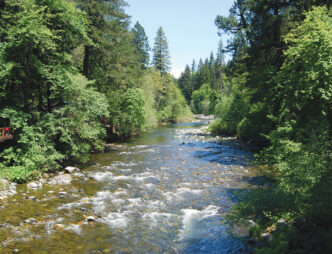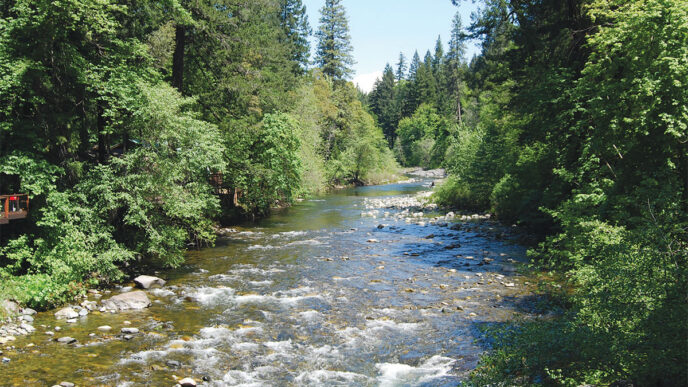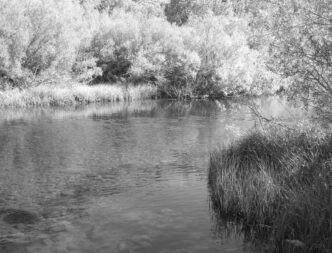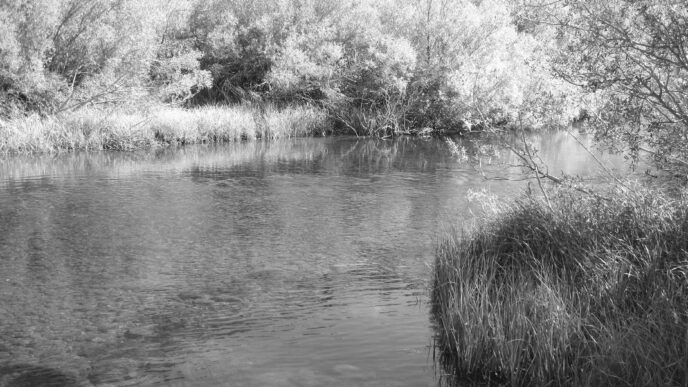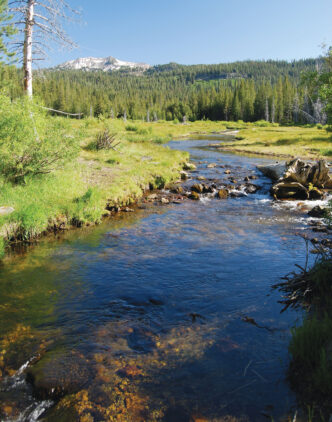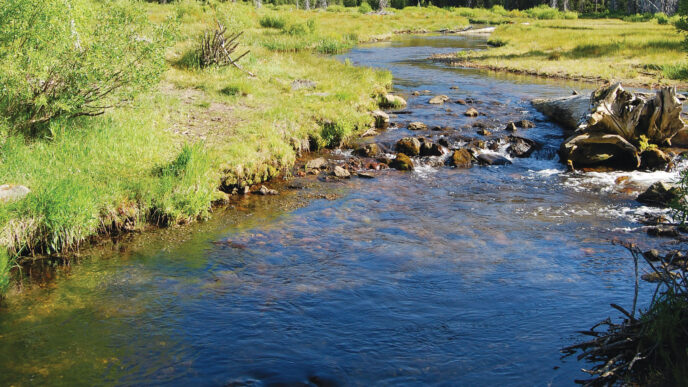Last year’s rim fire, the third largest wildfire in California’s history, brought national attention to the Gold Rush-era town of Sonora, which is situated a short drive north of Yosemite National Park, at the juncture of Highways 49 and 108. It was the sort of attention that is never desired by a community whose economy is based in large part upon the expenditures of visitors. “We had a complete fall-off in tourism,” said Nancy Sikes, executive director of the Tuolumne County Visitor’s Bureau. “Businesses were seeing no business, except for firefighters and recovery-team members, who filled the hotel rooms and restaurants.” The fire, started by a hunter’s illegal campfire, burned nearly 280 square miles of forest over a two-month-plus period.
Knowledgeable anglers watched the spread of the fire with alarm. It was affecting not only trout waters in and near Yosemite, it was advancing northward toward quality fisheries east of Sonora. Fire lines established south of Highway 108 held, however, and by the end of October, the fire that had started in August was finally extinguished. Judging from an aerial map of the fire’s perimeter, the section of the Clavey River reached by a Forest Service road out of Long Barn was saved, although much of its canyon downstream was scorched, as was the canyon of the Tuolumne River and tributaries down to near its confluence with the North Fork Tuolumne. Those loses are of deep concern, certainly, but the Tuolumne County streams and lakes accessed directly through Sonora were, for the most part, otherwise unaffected.
It’s odd calling Sonora a “trout town” — it hasn’t had a full-service fly shop since the Mother Lode Fly Shop closed years ago (a new shop, Fish On, is located nearby in Twain Harte), and although the Sierra region that the town services is one of the closest to the San Francisco Bay Area, fly fishers tend to prefer making longer drives to the Lake Tahoe area, the eastern Sierra, and the waters farther north around Redding. Still, there are decent fly-fishing opportunities in the Sonora area that deserve consideration. They’re accessed from Highway 108, which heads into the Stanislaus National Forest east of town. Sonora, established 163 years ago and still retaining the charm and sense of history of its early days, represents the gateway to these waters. Here is list of some of the opportunities you’ll find for tossing a fly.
The Middle Fork Stanislaus River. From the dam at Beardsley Lake to the Forest Service bridge at Spring Gap, this river is special-regulation water, requiring the use of barbless lures and limiting anglers to two trout of 14 inches or larger.
(Although many fly fishers catch and release here.) Beardsley’s afterbay is open to fishing all year long, while the river below is open only during the regular trout season. You can either park at the afterbay and hike downstream, or drive along a Forest Service road to the Spring Gap campground and hike upstream. Some anglers have reported good angling downstream of Spring Gap.
Above Donnell Lake, the Middle Fork runs along Highway 108 between Kennedy Meadow and the highway’s intersection with Clark Fork Road. The water here is smaller and often has been planted to enhance angling opportunities for the campgrounds that line the road.
The Clark Fork of the Stanislaus River. With the nine-mile-long Clark Fork Road providing easy access, the Clark Fork of the Stanislaus is popular with anglers during summer and autumn, particularly given that public campgrounds and private camps are situated along this road. To avoid the crowds, look for spots that are a long walk from the campgrounds and that require a bit of a hike from where you park. This is a classic Sierra freestone stream, and standard attractor patterns will usually work just fine. Although it is stocked during summer, you will likely catch wild trout, as well.
The Clavey River. The Clavey is notable because it is a 47-mile-long Sierra river that is undammed, and also because it was one of the first waters entered into the California Department of Fish and Wildlife’s Wild Trout Program. Given that many anglers don’t fish very far from their vehicles, you’ll have your best luck taking a bit of hike upstream or downstream of where the Forest Service road out of Long Barn crosses the river, which is more like a large creek at this spot. Expect small, but feisty trout that will come readily to attractor patterns. Be careful traversing the steep granite slopes if you’re wearing felt-soled wading boots, as you may end up sliding into the stream.
On your drive, you’ll pass over the North Fork of the Tuolumne. The water here has been stocked in the past, and can receive a lot of pressure during the fishing season. Maybe worth a hike away from the crossing. Maybe not.
The South Fork Stanislaus River. If you’re willing to hike and explore, the section of this fork of the Stan between Pinecrest Lake and Lyons Reservoir can sometimes offer interesting angling for fly fishers. Other sections between Pinecrest and Strawberry and near the Frasier Flat campground are more easily accessed and sometimes stocked, and thus receive a lot of pressure.
The Emigrant Wilderness. “You’ll need to put in a full day of hiking — or maybe two — in order to reach Emigrant Lake, deep in the Emigrant Wilderness,” states the Sonora Pass Vacations Web site, “but your efforts will be rewarded with great fishing. Nearby lakes such as Huckleberry Lake, Big Lake, and Buck Lakes are equally as good for fly fishing.” A useful guidebook for backpacking, which also has angling information, is Emigrant Wilderness and Northwestern Yosemite, written by Ben Schifrin and published by Wilderness Press.
Wild Cards. Pinecrest Lake is a very popular tourist destination and a stocked fishery. It might be worth checking out with a fly rod if you’re camping there, but few consider it a fly-fishing destination. Beardsley Reservoir is also easy to reach, but most fly fishers focus on the afterbay and the Middle Fork Stan downstream, both of which, as noted, are special-regulation waters. Upstream from Beardsley, Donnell Lake is a beautiful impoundment in a steep canyon that is difficult to reach (recommended: a high-clearance vehicle). It’s status as a fishery is pretty much unknown; rugged terrain makes launching boats there very difficult, although some people manage to maneuver small, hand-launched craft down to the water. By the way, the stretch of river between Donnell and Beardsley sees relatively few anglers. Lyons Reservoir, a planted fishery, is a nobody-contact lake, which means no wading or float tubing.
Just north of Jamestown is the huge impoundment of New Melones Lake on the Stanislaus River. It’s considered by conventional-tackle anglers as “the Gold Country’s best kept secret”; fly fishers who have boats and are adept at fishing foothill lakes might consider exploring this reservoir for a variety of species, but otherwise its qualities for fly fishers are unknown.
As with all of the Sierra, Tuolumne County has a number of creeks that are filled with small trout that can provide fun sport. If you’re interested in seeking them out, as well as more fully exploring the waters noted above, be sure to purchase a copy of the Stanislaus National Forest map that is available at any ranger station along Highway 108. It depicts roads and whether land is privately or publically owned.
The Lower Stanislaus. Finally, starting not too many miles west of Sonora, the Stanislaus River from Goodwin Dam (Tulloch Reservoir) to the Highway 120 Bridge in Oakdale is an artificials-only, catch-and-release water that’s open from the beginning of January through the end of October. The stretch between the Dam and Knights Ferry is a trout fishery. Below that, warmwater species become the focus.
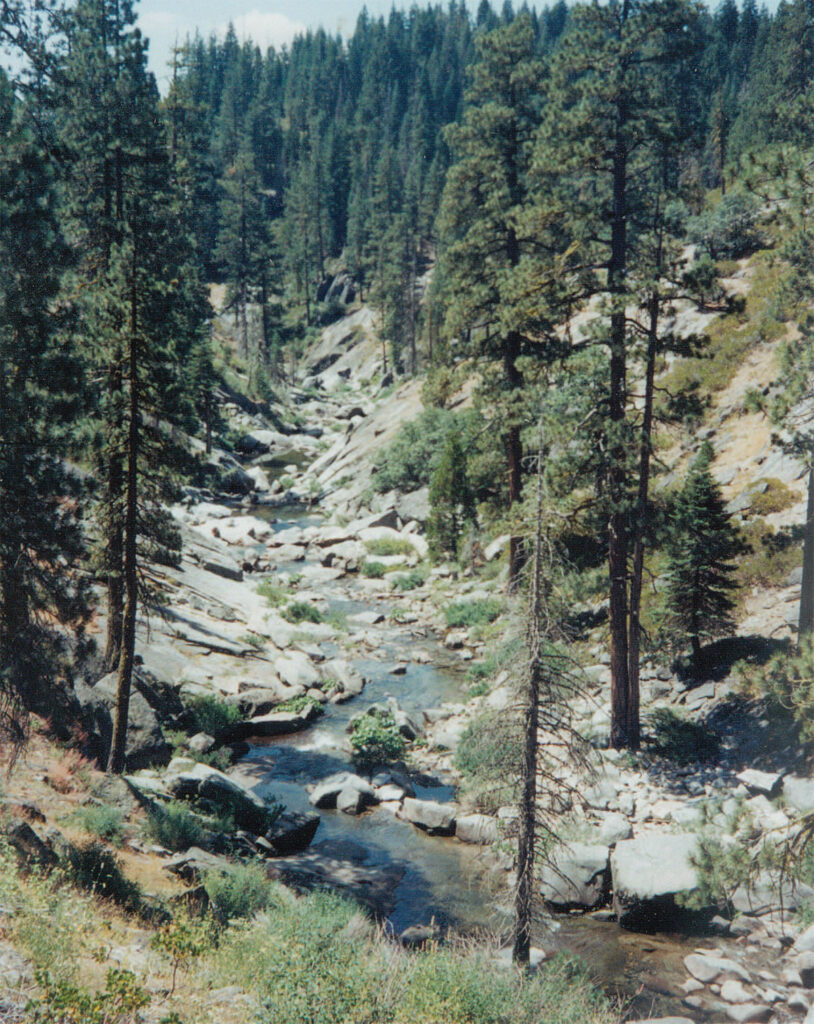
Resources for Visitors
Here is a compendium of fly-fishing resources, businesses, and places to eat in the Sonora area.
Fly Fishing
Mark Cottrell is Sonora’s only flyfishing guide. He can be contacted at (209) 536-9364. E-mail: mcffgs@gmail.com; on the Web at http://www.markcottrellguideservice.com.
The Fish On fly shop is located in the back of The Nest and Nursery, 23039 Fuller Road, Twain Harte. Phone (209) 586-1626. On the Web at Https://www.facebook.com/FishOnFlyGear. The shop is run by Josh Brockett.
The Mother Lode Fly Fishing Club has a Facebook page at https://www.facebook.com/pages/Mother-Lode-Fly-Fishing-Club/131514600350660.
Dave’s Sierra Fishing offers angling information for the entire Sierra region, including Tuolumne County. On the Web at countyfishing/fishing_yosemite.html.
Good Eats
The Sonora area has many good places to eat, but here are some favorites of the locals.
The Peppery is a family-owned restaurant with a menu of that includes great appetizers (try the onion strings) and 14 beers on tap. It’s at 13494 Mono Way in Sonora. Phone (209) 533-9033; on the Web at The_Peppery/Home.html.
The Diamondback Grill is known for its half-pound burgers made from meats from farms around Sonora. It also offers chalkboard specials. It’s at 93 South Washington Street, Sonora. Phone (209) 532-1227; on the Web at http://www.thediamondbackgrill.com.
The Homeplace is another family owned restaurant that serves products from their Montezuma Ranch. It’s at 1210 Sanguinetti Road, Sonora. Phone 209532-4113; on the Web at http://www.thehomeplacesonora.com.
Gus’s Steak House is a local Sonora institution that specializes in — what else? — steak, but also has a full menu and early bird specials. Its owner is Gus Tasiopolis, a local legend in the restaurant business. It’s at 1183 Mono Way, Sonora. Phone (209) 532-5190.
The 1859 Historic National Hotel and Acclaimed Restaurant’s name says it all, but it has a great reputation for its excellent food and old-time saloon. It’s at 18183 Main Street, in Jamestown. Phone (209) 984-3446.
The Willow Steak House and Saloon is a popular place with an added feature — its own friendly female ghost, left over from when the place was a hotel that was burned down by a fire set by the ghost, or so the story goes. It’s at 18723 Main Street at Willow, Jamestown. Phone 209-9843998; on the Web at http://www.willowsteakjamestown.com.
Christopher’s Ristorante is a well-regarded restaurant located in the Sonora Inn, 160 South Washington Street, Sonora. Phone (209) 533-2600; on the Web at http://christophersristorante.com/wp.
Seven Sisters is an upscale restaurant in the Black Oak Casino, 19400 Tuolumne Road North, Tuolumne. Phone (877) 7478777; on the Web at http://www.blackoakcasino.com/restaurants-bars/seven-sisters. The casino has a great local reputation for supporting worthy community and civic causes.
The Sonora Creamery has lots of ice cream specialties and a full sandwich menu. It’s at 448 South Washington Street, Sonora. Phone (209) 532-7221.
The Twain Harte Market is a little place that has a deli and is a good spot to stock up with natural foods for a fishing trip. The market is known for its own home-baked bread. It’s address is 18711 Tiffeni Drive in Twain Harte. Phone (209) 586-6100; on the Web at http://www.twainhartemarket.com.
More Information
The Tuolumne County Visitors Bureau, 542 Stockton Street, P.O. Box 4020, Sonora, CA 95370. Phone 209-533-4420, 800-446-1333; e-mail tcvd@mlode.com; on the Web at http://tcvb.com.
The Sonora Chamber of Commerce, P.O. Box 3084, Sonora, CA 95370. Phone (209) 694-4405; on the Web at http://www.sonorachamber.com.
The Stanislaus National Forest, online at http://www.fs.usda.gov/stanislaus. Supervisor’s Office, 19777 Greenley Road, Sonora, CA 95370. Phone (209) 532-3671
The Mi-Wok Ranger District, 24695 Highway 108, Mi-Wuk Village, CA 95346. Phone (209) 586-3234. The Summit Ranger District, #1 Pinecrest Lake Road, Pinecrest, CA 95364. Phone (209) 965-3434.



